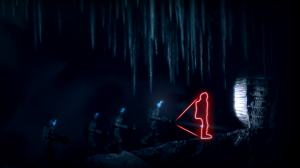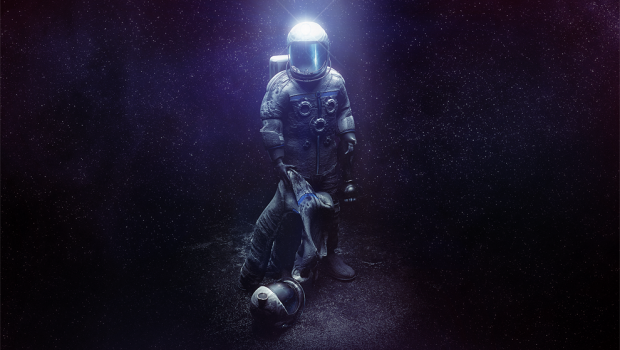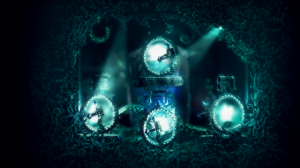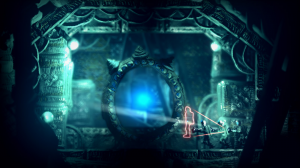The Swapper: Think Like a Dinosaur
In James Patrick Kelly’s 1996 Hugo-winner novella “Think Like a Dinosaur,” humanity has been given the gift of the stars by a reptilian alien race: the Hanen, nicknamed “dinosaurs.” Most people think that interstellar travel works as teleportation. They are mistaken; it’s actually duplication, and once the duplicate’s safe arrival has been confirmed, the original is immediately, quickly, humanely, and discreetly disposed of. To the Hanen, the thought of multiple copies of the same consciousness co-existing in the universe is anathema. So when humanity’s first stargate operator learns that a “failed” teleportation succeeded after all, the Hanen brusquely tell him that he needs to fix things. To “balance the equation.” Upsetting the dinosaurs could threaten mankind’s first tenuous foothold into the universe… Doing what they ask means killing a teenage girl.
The Swapper teaches the player to think like a dinosaur.
An atmospheric SF puzzle-platformer made entirely from clay, The Swapper takes its tonal cues from Ridley Scott’s Alien (not the more commonly aped Aliens) and the oppressing loneliness of survival horror. As you explore the abandoned space station Theseus, you are both alone and not; the primary mechanic is creating “clones” of yourself to solve puzzles. Clones do what the original tells them, but the “original” that carries your consciousness can be swapped at any time. Clones can die, but as long as the player wasn’t “inside” that clone at the time of death, the game continues.
…Clones “can” die. What a laugh. Clones will die. Clones will fall off ledges. Clones will drown, clones will suffocate. Clones will be sacrificed. Clones will be murdered. Clones will be slaughtered by the hundreds as the player mercilessly shoves their own selves into an endless meat-grinder. At the end of the game, your victory flag will be planted atop a pile of corpses and all of them are yours.
The first time the game makes you kill yourself, it’s unnerving. At first, death is just a thing that can happen, as impersonal as the emptiness of space itself. But the game soon tires of playing coy and puts an obstacle in your way that can only be passed by intentionally killing one of your clones. The gamer in you understands implictly; the person in you may have some reservations. But still, you send a clone to its death, swapping your consciousness out just before the moment of impact. It worked! And you’re still here; the game’s still going. So where’s the harm?
Death has been with videogames since the beginning; the ultimate, inarguable failure state. Mario starts each attempt to rescue the princess with three lives (or, as a friend of mine literally called them, “three men”). But these “lives” are just a metaphor; a way to sweep mistakes under the rug and give the player multiple tries to get things right. By the end of the game, the protagonist’s understanding of what transpired has been fragmented into countless parallel worlds. “Yes, you died, but what if…” Literally, in 2003’s Prince of Persia; player death is cleverly explained away as the Prince misremembering how things transpired.
 The Swapper’s gameplay neatly slices this Gordian narrative knot by making the metaphor literal. Clone A creates Clone B; Clone B replaces Clone A. Clone A may be dead now, but for a moment, they overlapped, and during that moment, the spark of player consciousness leapt from one to the next. The clones died, but the player didn’t, and that grisly through line is how they understand what’s happening. At first, it seems like just another mechanic, but as more and more copies are killed, the idea of an “original” is rendered completely ridiculous: augmenti ad absurdum. The game desensitizes the player through sheer repetition, and what begins as horror soon becomes farce. It turns out that comedy’s not just tragedy plus time; it’s also tragedy times volume.
The Swapper’s gameplay neatly slices this Gordian narrative knot by making the metaphor literal. Clone A creates Clone B; Clone B replaces Clone A. Clone A may be dead now, but for a moment, they overlapped, and during that moment, the spark of player consciousness leapt from one to the next. The clones died, but the player didn’t, and that grisly through line is how they understand what’s happening. At first, it seems like just another mechanic, but as more and more copies are killed, the idea of an “original” is rendered completely ridiculous: augmenti ad absurdum. The game desensitizes the player through sheer repetition, and what begins as horror soon becomes farce. It turns out that comedy’s not just tragedy plus time; it’s also tragedy times volume.
This narrative backdrop is a natural fit for games, where continuous, repeated death is the order of the day. Yet games rarely bring this subtext forward into text. Perhaps because the topic is difficult to address without it taking over all aspects of the game, dragging everything else down into existential horror. The only other game I can think of to address it so directly is Adam Cadre’s terrifying Shrapnel.
 It’s too bad. Duplicate-killing’s not just good gameplay; it’s good storytelling. The Swapper is the latest in a long tradition of speculative fiction exploring duplicates and death. Algis J. Budrys’ Rogue Moon is the clearest example, a novel of an endless parade of duplicates exploring a incomprehensible and deadly lunar labyrinth. William Sleator’s The Duplicate, like all his books, is uncut nightmare fuel disguised as a Scholastic Book Fair thriller. Christopher Priest’s The Prestige, adapted by Christopher Nolan for the screen in 2006, also has a murderous copying device at its core.
It’s too bad. Duplicate-killing’s not just good gameplay; it’s good storytelling. The Swapper is the latest in a long tradition of speculative fiction exploring duplicates and death. Algis J. Budrys’ Rogue Moon is the clearest example, a novel of an endless parade of duplicates exploring a incomprehensible and deadly lunar labyrinth. William Sleator’s The Duplicate, like all his books, is uncut nightmare fuel disguised as a Scholastic Book Fair thriller. Christopher Priest’s The Prestige, adapted by Christopher Nolan for the screen in 2006, also has a murderous copying device at its core.
It’s a theme authors return to time and again, yet The Swapper may be its purest expression yet. Making the player active and complicit in the killing forces them to face the reality head on, and it can be shockingly unpleasant. Nobody likes killing themselves, even when it’s necessary. But it is necessary. Just ask the Hanen.








